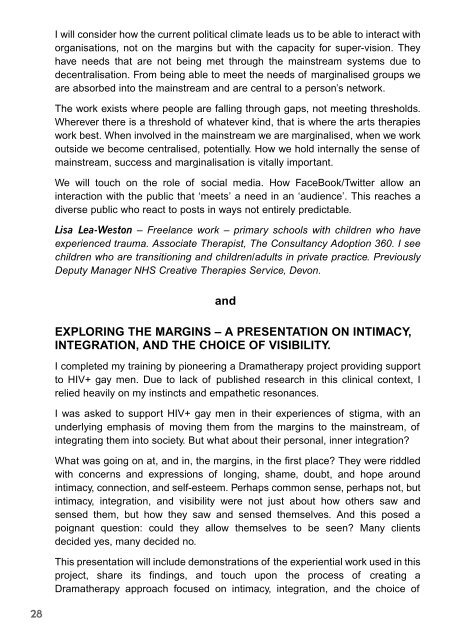On the Edge
dramatherapy_conference_2016_online_form
dramatherapy_conference_2016_online_form
You also want an ePaper? Increase the reach of your titles
YUMPU automatically turns print PDFs into web optimized ePapers that Google loves.
I will consider how <strong>the</strong> current political climate leads us to be able to interact with<br />
organisations, not on <strong>the</strong> margins but with <strong>the</strong> capacity for super-vision. They<br />
have needs that are not being met through <strong>the</strong> mainstream systems due to<br />
decentralisation. From being able to meet <strong>the</strong> needs of marginalised groups we<br />
are absorbed into <strong>the</strong> mainstream and are central to a person’s network.<br />
The work exists where people are falling through gaps, not meeting thresholds.<br />
Wherever <strong>the</strong>re is a threshold of whatever kind, that is where <strong>the</strong> arts <strong>the</strong>rapies<br />
work best. When involved in <strong>the</strong> mainstream we are marginalised, when we work<br />
outside we become centralised, potentially. How we hold internally <strong>the</strong> sense of<br />
mainstream, success and marginalisation is vitally important.<br />
We will touch on <strong>the</strong> role of social media. How FaceBook/Twitter allow an<br />
interaction with <strong>the</strong> public that ‘meets’ a need in an ‘audience’. This reaches a<br />
diverse public who react to posts in ways not entirely predictable.<br />
Lisa Lea-Weston – Freelance work – primary schools with children who have<br />
experienced trauma. Associate Therapist, The Consultancy Adoption 360. I see<br />
children who are transitioning and children/adults in private practice. Previously<br />
Deputy Manager NHS Creative Therapies Service, Devon.<br />
and<br />
EXPLORING THE MARGINS – A PRESENTATION ON INTIMACY,<br />
INTEGRATION, AND THE CHOICE OF VISIBILITY.<br />
I completed my training by pioneering a Drama<strong>the</strong>rapy project providing support<br />
to HIV+ gay men. Due to lack of published research in this clinical context, I<br />
relied heavily on my instincts and empa<strong>the</strong>tic resonances.<br />
I was asked to support HIV+ gay men in <strong>the</strong>ir experiences of stigma, with an<br />
underlying emphasis of moving <strong>the</strong>m from <strong>the</strong> margins to <strong>the</strong> mainstream, of<br />
integrating <strong>the</strong>m into society. But what about <strong>the</strong>ir personal, inner integration?<br />
What was going on at, and in, <strong>the</strong> margins, in <strong>the</strong> first place? They were riddled<br />
with concerns and expressions of longing, shame, doubt, and hope around<br />
intimacy, connection, and self-esteem. Perhaps common sense, perhaps not, but<br />
intimacy, integration, and visibility were not just about how o<strong>the</strong>rs saw and<br />
sensed <strong>the</strong>m, but how <strong>the</strong>y saw and sensed <strong>the</strong>mselves. And this posed a<br />
poignant question: could <strong>the</strong>y allow <strong>the</strong>mselves to be seen? Many clients<br />
decided yes, many decided no.<br />
This presentation will include demonstrations of <strong>the</strong> experiential work used in this<br />
project, share its findings, and touch upon <strong>the</strong> process of creating a<br />
Drama<strong>the</strong>rapy approach focused on intimacy, integration, and <strong>the</strong> choice of<br />
28


